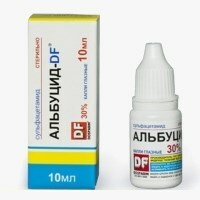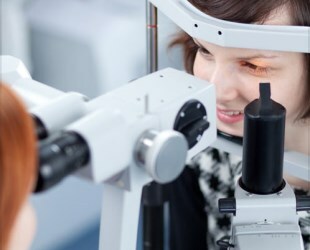
Eye drops are used not only to relieve dry eye syndrome or treat various diseases.
There are such drugs that doctors use to diagnose and study the causes of visual impairment in patients.
One such is Tropicamide. Its main property is the ability to expand the pupil with a simultaneous obstacle to its narrowing.
This action of the drug is used in the practice of ophthalmology when it is necessary to examine the fundus and treat adhesions and inflammations of the eyes.
- 1. Instructions for use
- 2. Contraindications
- 3. Analogs and synonyms
- 4. Storage and price
- 5. Patient's feedback
- 6. Conclusion
- 7. Video
Instruction for use
Form of preparation and qualitycomposition
To date, the only drug form of release of Tropicamide is droplets. It is a colorless, clear liquid, packed in a plastic vial with a dropper dispenser.
Two dosage options are available - 0.5% active ingredient and 1%. In the first case, 1 ml of Tropicamide contains 5 mg of the active ingredient, in the second variant - 10 mg. The active ingredient is the chemical Tropicamide.
As auxiliary components are:
- sodium chloride( otherwise table salt),
- sodium EDTA,
- hydrochloric acid,
- benzalkonium chloride,
- deionized and highly purified water.
Therapeutic effect
Tropicamide is a member of the M-holinoblokatorov group. In other words, it has the ability to block M-holinoretseptory, available in the vessels and muscles of tissues with organs, including the iris of the eye and its ciliary muscle. The result of this action is the effect of relaxing the muscles for a short time.

Pay attention - the instruction and the price for eye drops Albucid. What is the purpose of these droplets?
In the news( here) reviews about Allergoode.
Analogues Sofredex!http: //moezrenie.com/lechenie/ kapli-dlya-glaz / preparat-sofradeks.html
When the iris and muscles relax, the pupil is maximally dilated with simultaneous muscle blocking( paralysis of accommodation), which are unable to respond at this time to changes in the light beam. That is, the maintenance of muscles in relaxation Tropicamide retains the pupil in an expanded form.
The pupil begins to expand after about 5-10 minutes. The maximum dilatation in the pupil is achieved after administration in 15-20 minutes. This condition lasts for an hour when instilled with 0.5% drops and for 2 hours from 1% of the composition. Normal recovery of the pupil occurs in 5-6 hours.
Often the effect of Tropicamide is compared with Atropine, which is stronger than ophthalmotonus. But such a relaxed effect does not exclude the possibility of increasing intraocular pressure.
Precautions
When you administer the medicine, you need to pinch the tear canal with your finger and hold it for two to three minutes. This measure serves to prevent solution from entering the nasopharynx from where it can completely absorb into the bloodstream.
Photophobia and a visual disturbance caused by instillation with Tropicamide alone pass after the end of the remedy.
If necessary, treatment of children under the age of 6 years, use Tropicamide 0.5%.To exclude the risks of systemic effects of the drug, it must be diluted with a physiological solution in a proportion of 1: 1. As a result, a 0.5% solution must be converted into 0.25%.Only in this form it can be buried in children. Dilute the drops with a sterile saline solution.
Combination with other medicines
If tropicamide is used together with neuroleptics, antidepressants and histamin blockers, then there is a mutual reinforcing effect from the effects of eye drops and these drugs.
Summation of Tropicamide with nitrites( eg, nitroglycerin) and glucocorticosteroids significantly increases intraocular pressure.
For whom the tool
is intended The drops are used for the purposes of:
- diagnosis,
- preparation for surgery,
- treatment.
From the point of view of diagnosis, Tropicamide is used for:
- eye lens check,
- examination of the fundus,
- for refractive analysis of the eye.

For surgical purposes, droplets are used for:
- cataract extraction, or eye lens surgery,
- retinal laser therapy( laserocoagulation),
- for vitreous surgery and ocular retina.
Treatment with eye drops suggests:
- complex therapy of eye inflammations( keratitis, uivitis, iridocyclitis),
- prophylaxis of synechia after surgical intervention.
How to use the drops

The traditional way of using eye drops is to instill them into the lower region of the conjunctival sac.
This procedure can be performed with a pipette or a special dropper attached to the vial.
1% solution is injected into the eye each drop by drop. Treatment lasts 2 - 4 weeks.
In case of using a dropper, it is best not to touch its tip. Otherwise, it can become contaminated and enter the eye of microbes. If you have contact lenses before the procedure, they need to be removed.
After half an hour after it, contact lenses can be worn. This applies to hard contact lenses. As for soft lenses, they should not be used at all during treatment. This is due to the danger of deposition of benzalkonium chloride on their surface.
Use in childhood
When treating children under six years of age, only drops of 0.5% Tropicamide can be used. To minimize the risk of side effects, the drug should be diluted with sterile saline in equal parts. Thus, a solution of a concentration of 0.25%, which is ideal for use in children, can be obtained. Bury the eyes of children preferably before going to bed. The drug should be injected one drop into each eye, and the duration of the therapeutic course should be from two to four weeks.
When using Tropicamide for the treatment of newborns, extreme care should be taken since this drug can cause a disorder of the central nervous system.
Degree of exposure
To maximize the pupil, a drop of a solution of 1% or two drops of 0.5% is enough. In the latter case, the interval between the drops should be about five minutes. After 10 minutes, the pupil is dilated, which makes it possible to perform diagnostics.
To investigate refraction, it is necessary to develop a paralysis of accommodation. To do this, 1% solution is injected into the conjunctival sac six times, one drop each, with a break of 6-12 minutes. Refraction can be investigated in the range of 25-50 minutes after the sixth drop.
Contraindications
Bovine eye Tropicamide is contraindicated in the presence of:
- closed-angle and mixed primary glaucoma,
- sensitivity to the drug,
- increased intraocular pressure,
- intolerance to its components,
- allergic reaction.
Use of the drug requires caution in pregnant and lactating women, as well as in the treatment of infants.
Kinds of side effects of
The consequence of using Tropicamide may be side effects of local and systemic nature.
Local effect is manifested by negative symptoms in the eyes and eyesight region:
- photophobia,
- accommodation disorder,
- increased ophthalmotonus,
- decreased visual acuity,
- burning in the eyes,
- attack of the closed-angle glaucoma,
- increased intraocular pressure.
Systemic adverse effects are possible if the agent enters the bloodstream in the form:
- obstructed urination,
- pressure drop due to vasodilatation,
- suppression of sweating,
- dry mouth,
- secretion of the mucous membranes,
- tachycardia,
- bowel hypotension,
- headachepain,
- of nervous excitation,
- increase in temperature.
These factors are especially characteristic for people of advanced age and children. Read more - eye drops Levomycetin. Description of the preparation.
In the article( link) the price of Cyclomed.
Instruction and price for Maxitrol!http: //moezrenie.com/lechenie/ kapli-dlya-glaz / kombinirovannye-kapli-maksitrol.html
Analogues and synonyms
In the domestic market of pharmaceuticals, Tropicamide has analogues and synonyms. Drugs containing the active ingredient Tropicamide in the same concentration are synonymous.
Analogues have a spectrum similar to this drug, but with other chemical compounds in the form of active components.
Synonyms for Tropicamide are eye drops:
- Midratsil,
- Midrum,
- Midriaticum-Stultn,
- Uniotropin,
- Tropikamyt.
The analogs are:
- Cyclomed( eye drops),
- Cycloptic( eye drops),
- Atropine( ointment and eye drops),
- Ophthalmic films with atropine sulfate.
Storage and price
Preparation Tropicamide must be stored in its original sealed packaging. The storage location must have a temperature of up to 25 ° C, out of the reach of children and protected from light.
The expiration date is three years. The opened vial is stored no more than 4 weeks.
In pharmacies of Russia, Tropicamide 0.5% costs an average of 70-85 rubles., 1% - 130-140 rubles. In the pharmacy chains of Ukraine, the average price of the drug: 0.5% - 19-32 UAH., 1% - 35-50 UAH.
Patient Reviews
Patients respond about drops of Tropicamide in different ways. Some people claim that this drug quickly helped them cure conjunctivitis, relieve spasm and tired eyes, remove redness and pain. Some patients are confident that it was Tropicamide that helped them restore vision.
There are also reviews in which people point out the shortcomings of Tropicamide , , namely the occurrence of burning and severe pain when injected and photophobia after use. Patients also show that the use of Tropicamide has a negative effect on the central nervous system , which is expressed in drowsiness and weakness.
Examples of

# 1. The ophthalmologist asked me to examine the fundus. For this he used eye drops Tropicamide. The doctor warned that as a result of instillation, my eyesight may drop and a headache may appear( as the eye pressure rises).But the examination was easy, the vision did not change, and side effects did not occur.
# 2. The doctor advised me to drip into the eyes of Tropicamide, because the vision test produced poor results. At first I did not want to buy, as I read on the Internet that it was a narcotic substance. But all the same I bought it, which I did not regret. Vision quickly recovered.
Most adults and parents who have undergone eye examination with Tropicamide respond positively to the drug. They note a slight visual impairment at the very beginning and a tingle in the eyes. But this short-term state is easily tolerated even by children. The total opinion about these eye drops reduces to a positive evaluation.
Conclusion
- Tropicamide is an ophthalmic drop used to treat various eye diseases and prepare for medical manipulation.
- There are certain contraindications to the use of this drug.
- When using this drug to treat pregnant women, infants and elderly patients, extreme care should be taken.
- Using Tropicamide can cause unpleasant side effects.
- Tropicamide can be replaced with a similar preparation, after consulting with a doctor.
Video
This video might be interesting for you:
